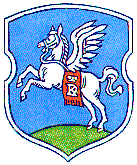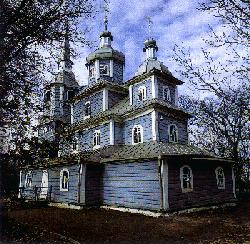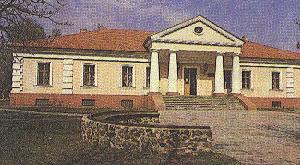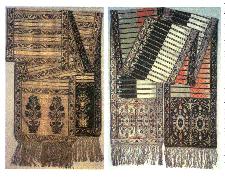![]()

Slucak (pronounced Slutsak) is the centre of the Slucak (pronounced
Slutski) district, Miensk region, situated on the Sluc river, 105 km South of the capital
Miensk (Minsk).
Population: 62,800 (1995)

Slucak was first mentioned in the chronicles of 1116. It was then part of the Turau principality. In 1160 Slucak became the capital of its own principality. From approximately 1320-1330 onwards it belonged to the Grand Duchy of Lithuania, the first Belarusan state (see also The origins of the GDL).
From 1395 the city was the centre of an appanage principality belonging to Uladzimir Al'herdavic and his successors, the Alel'kavic family. In 1411 Slucak was granted the so-called Magdeburg law (the comparatively progressive German code of law ot the time, which was adopted in many parts of Eastern Europe) wit the coat of arms . The last heiress of the Alel'kavic family married Janus Radzivil and when she died in 1612 the city was given to the Radzivil family.

In the 17th century Slucak was one of the most significant cities in the country. Despite several crises, such as the threat posed by the Crimean Tartars, wars with Russia and internal conflicts, Slucak was a famous trade and manufacturing centre. The city was under the patronage of the Radzivil family, who were protectors of the reformist and orthodox faith.
Several examples illustrate the development of the city. In 1581 a print workshop was opened and in 1617 the Slucak Calvinist grammar school was founded. Later, in the 18th century, the theatre and ballet school were founded. Young Belarusan (Lithuanian) Protestants were encouraged to receive their education abroad, at the universities of Oxford, Königsberg or Berlin. In fact, the Protestants were so well protected that many other Calvinists came to Slucak, even from abroad, fleeing persecution at home and seeking the protection of the Radzivil family. In the 17th century, for example, a great number of Scottish colonists settled in and around Slucak. With their knowledge and experience they made an important contribution towards the development of trade and manufacturing processes.
The belt factory in Slucak was famous throughout the country and in Poland as well. At
that time, belts were not just a decorative accessory, but were indispensable for every
noble. Belts were woven out of golden and silver silk and usually measuring 2-4.5 metres
in length and 20-40 cm in width. At first, patterns from the Middle East were imitated and
used for the belts, later manufacturors developed their own local patterns with motifs of
different kinds. All Slucak belts are characterised by golden inscriptions embroidered on
the fabric, sometimes in Latin, such as "Factus est Sluciae".

After the second division of the Polish-Belarusan state Rec Pospolita (meaning republic) in 1793, Slucak became part of the Russian empire.
From the 15th to 17th century, Slucak had three castles - the Verchni zamak (Upper castle), Nizni zamak (Lower castle) and the Novy zamak (New castle) or Zitadel - and many churches including both Catholic and Calvinist, two synagogues, a monastery and a convent. Today, there is almost nothing left of these buildings.
In 1919, the city became part of the Belorussian Socialist Soviet Republic. In November and December 1920 Slucak was the centre of an anti-Bolshevik Uprising (The Slucak defense action). The defenders declared the Slucak region part of the Belarusan People's Republic (independent republic declared 1918 on the territory inhabited by Belarusans after the collapse of the Russian Empire). The first Belarusan Convention of the Slucak Region was held, a parliament (Rada) was elected and two regiments (4000 soldiers) were formed, which fought against the Red Army for about two months, before being defeated. The uprising was put down.
This page is part of the Virtual Guide to Belarus - a collaborative project of Belarusian scientists abroad Go to Belarusian towns, cities and several villages - Go to Belarusian Heritage main page © 1995-2004 VG |
 |